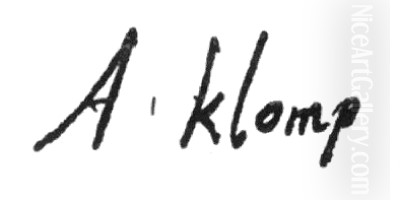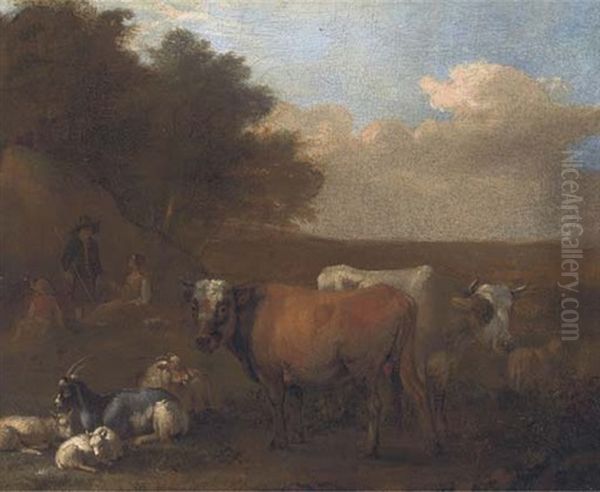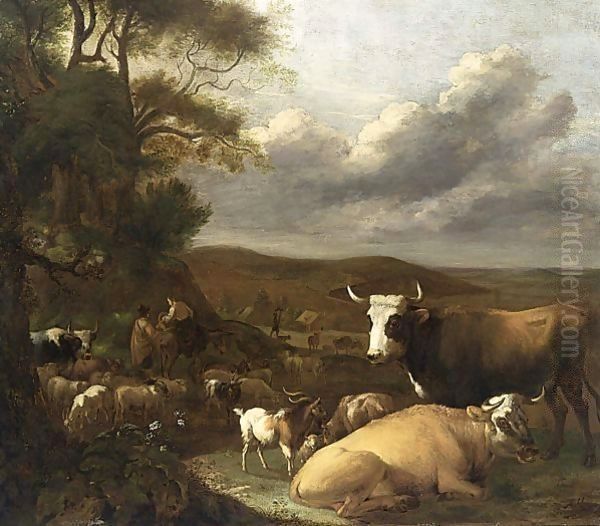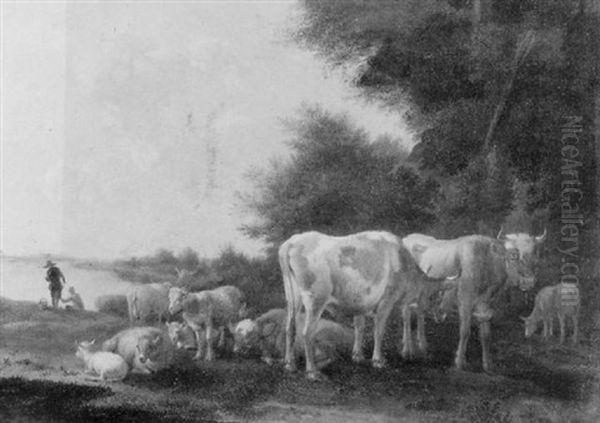
Albert Jansz Klomp (1618-1688) stands as a notable, if sometimes overlooked, figure among the legion of talented painters who characterized the Dutch Golden Age of the 17th century. While perhaps not possessing the widespread international fame of contemporaries like Rembrandt or Vermeer, Klomp carved out a significant niche for himself as a specialist in pastoral landscapes, particularly those featuring cattle. His works offer a charming and idyllic vision of the Dutch countryside, reflecting a broader cultural appreciation for rural life and the burgeoning national pride of the newly independent Dutch Republic. This exploration delves into the life, artistic style, significant works, and the broader context of Albert Jansz Klomp, situating him within the rich tapestry of 17th-century Dutch art.
The Dutch Golden Age: A Flourishing of Art
To understand Albert Jansz Klomp, one must first appreciate the extraordinary artistic environment in which he worked. The 17th century in the Netherlands, often termed the Dutch Golden Age, was a period of unprecedented economic prosperity, scientific advancement, and cultural flourishing. Following its independence from Spain, the Dutch Republic became a dominant force in global trade, leading to a wealthy and increasingly urbanized merchant class. This new class of patrons, distinct from the traditional church and aristocratic patrons of other European nations, developed a taste for art that reflected their own lives, values, and surroundings.
This societal shift fueled an enormous demand for paintings. Artists began to specialize in various genres to cater to this diverse market: portraits, seascapes, cityscapes, still lifes, genre scenes (depictions of everyday life), and, crucially for Klomp, landscapes. Dutch landscapes, in particular, moved away from the idealized or mythological scenes popular elsewhere, focusing instead on the recognizable features of their own flat, water-rich terrain, or on more pastoral, sometimes Italianate-influenced, rural vistas. The specificity and realism, combined with an often-subtle evocation of mood and atmosphere, became hallmarks of Dutch landscape painting.
Klomp's Life and Career: Details and Dedication

Biographical details for many Dutch Golden Age painters, especially those who were not at the very pinnacle of fame, can be somewhat scarce, and Albert Jansz Klomp is no exception. He was born in Amsterdam in 1618, a bustling metropolis that was the heart of the Dutch Republic's commercial and artistic worlds. It is likely that he received his artistic training in Amsterdam, though the specific identity of his master remains uncertain. Some scholars have suggested a possible connection or influence from painters who were already established in the pastoral landscape tradition.
Klomp appears to have been active as a painter primarily in Amsterdam throughout his career. He married Annetje Pietersdr. Corens in 1653, and they had several children. His death is recorded in Amsterdam in 1688. While not a member of the highest echelons of painters who achieved great wealth or international renown, Klomp was a productive artist who found a consistent market for his specialized works. His paintings, typically modest in scale, were well-suited for the homes of the Dutch middle class.
The very act of specializing in cattle within landscapes indicates a focused artistic path. This specialization allowed painters like Klomp to hone their skills in rendering specific textures, animal anatomy, and the interplay of light on their chosen subjects, thereby appealing to collectors who appreciated such mastery.
Artistic Style and Subject Matter: The Bucolic Vision
Albert Jansz Klomp's oeuvre is characterized by its consistent dedication to pastoral scenes. His paintings almost invariably feature cattle as the central or prominent elements, set within serene and often sun-drenched landscapes.
Focus on Animals
The animals in Klomp's paintings, predominantly cows but sometimes including sheep, goats, and occasionally horses or a herdsman, are rendered with care and attention to detail. He demonstrated a good understanding of their anatomy and typical postures – whether grazing, resting, or wading in shallow water. His depiction of cattle is less monumental or heroic than that of, for example, Paulus Potter, whose "The Young Bull" became an icon of Dutch animal painting. Instead, Klomp's animals are integrated more naturally into the landscape, contributing to an overall sense of harmony and peace. The textures of their hides, the gentle expressions in their eyes, and their calm demeanor are hallmarks of his approach.
Landscape Elements

The landscapes themselves are typically idyllic and somewhat generalized, rather than being specific topographical views. They often feature lush meadows, clusters of trees with feathery foliage, tranquil ponds or streams, and a low horizon line that gives prominence to the expansive Dutch sky. While distinctly Dutch in feel, some of his works exhibit a soft, warm light that can evoke the Italianate landscapes popularised by artists like Nicolaes Berchem or Karel Dujardin, who had either travelled to Italy or were heavily influenced by artists who had. However, Klomp's settings generally remain more rooted in the Northern European pastoral tradition.
Light and Atmosphere
A key feature of Klomp's style is his handling of light and atmosphere. He often favored the warm glow of late afternoon or early morning sun, casting long shadows and creating a gentle, diffused light that bathes the scene in a tranquil ambiance. This use of light not only enhances the picturesque quality of his landscapes but also helps to unify the composition, drawing the viewer's eye across the canvas and highlighting the textures of the animals and foliage. The skies are often animated with soft clouds, contributing to the overall peaceful mood.
Compositional Tendencies
Klomp's compositions are generally balanced and uncluttered. He often arranged his cattle in small groups in the foreground or middle ground, with the landscape receding gently into the distance. Trees might frame one side of the composition, and a body of water often adds a reflective element. Human figures, when present, are usually subsidiary – a shepherd or milkmaid – serving to reinforce the pastoral theme rather than being the primary focus. This compositional clarity makes his works accessible and pleasing to the eye.
Representative Works: Themes and Variations
While specific titles of Klomp's most "famous" works are not as widely circulated as those of some of his contemporaries, his paintings are generally recognizable by their consistent subject matter and style. Many are titled descriptively, such as:
"Landscape with Cattle and Shepherd"
"Pastoral Scene with Livestock by a Stream"
A typical Klomp painting might depict a few cows, perhaps a mix of brown, black, and white, resting or grazing near a clump of trees. One cow might be standing, another lying down, and perhaps a third wading into a shallow pool of water. A shepherd might be seen in the middle distance, leaning on his staff, or a milkmaid attending to her duties. The scene would be illuminated by a soft, warm light, with a detailed rendering of the foliage and the animals' hides. The overall impression is one of rural peace and the simple, harmonious relationship between humans, animals, and nature.

His works can be found in various museum collections, including the Rijksmuseum in Amsterdam, and they occasionally appear at art auctions, testament to their enduring appeal for collectors of Dutch Golden Age art. The consistency of his output means that while individual works might vary in complexity or specific details, they collectively represent a cohesive body of work dedicated to the pastoral ideal.
Contemporaries and Influences: A Network of Specialists
Albert Jansz Klomp operated within a vibrant artistic community where specialization was common. His focus on cattle in landscapes places him in a lineage and alongside several important contemporaries.
Paulus Potter (1625-1654) is arguably the most celebrated Dutch painter of animals, particularly cattle. Though his career was short, Potter's meticulous realism and his ability to imbue his animal subjects with individual character set a high standard. Klomp’s work, while sharing the subject matter, is generally softer in execution and less monumental in conception than Potter's.
Adriaen van de Velde (1636-1672) was another highly skilled painter of landscapes with animals and figures. His works are known for their refined execution, delicate lighting, and graceful figures. Van de Velde often painted more varied scenes, including beachscapes and winter landscapes, but his pastoral scenes with cattle share a similar idyllic quality with Klomp's, though often with a greater degree of elegance and Italianate clarity.
Aelbert Cuyp (1620-1691), a contemporary from Dordrecht, was renowned for his luminous, golden-hued landscapes, often featuring cattle prominently. Cuyp’s mastery of light, frequently inspired by the Italianate style, created a distinctive atmospheric glow in his paintings. While Klomp's lighting is also warm, Cuyp's is generally more pronounced and suffused throughout the entire canvas, creating a more idealized and poetic vision.
Other artists who specialized in or frequently included cattle and pastoral themes include Karel Dujardin (1622-1678) and Dirck van Bergen (c.1645-c.1690). Dujardin, particularly, was known for his Italianate landscapes with peasants and animals, characterized by clear light and meticulous detail. Van Bergen was a pupil of Adriaen van de Velde and continued in a similar vein.
Beyond these direct specialists, the broader context of Dutch landscape painting included towering figures like Jacob van Ruisdael (c.1628-1682), known for his dramatic and evocative woodland scenes and seascapes, and Meindert Hobbema (1638-1709), famous for his detailed and picturesque depictions of wooded landscapes and watermills. While their subject matter differed, they all contributed to the rich tradition of depicting the Dutch environment and rural life.
The era also saw the flourishing of other genres, with masters like Rembrandt van Rijn (1606-1669) revolutionizing portraiture and biblical scenes, Johannes Vermeer (1632-1675) capturing serene interior genre scenes with unparalleled mastery of light, Frans Hals (c.1582-1666) known for his lively and characterful portraits, and Jan Steen (c.1626-1679) depicting boisterous and humorous everyday scenes. Even Pieter de Hooch (1629-1684), with his tranquil courtyards and domestic interiors, contributed to this rich artistic milieu. Klomp's work, therefore, represents one specific but important facet of this incredibly diverse artistic output.
Legacy and Collections: Enduring Pastoral Charm
Albert Jansz Klomp's legacy lies in his consistent and skilled contribution to the genre of pastoral landscape painting in the Dutch Golden Age. He was not an innovator who radically changed the course of art history, but rather a dedicated specialist who expertly catered to the tastes of his time for idyllic rural scenes. His paintings provided an escape from the bustling city life for many urban Dutch citizens, offering a vision of peace, harmony, and the simple beauties of nature and agricultural life.
His works are represented in numerous public collections across Europe, including the Rijksmuseum in Amsterdam, the Mauritshuis in The Hague (though perhaps less prominently than some other masters), and various regional museums in the Netherlands and beyond. Private collectors also continue to appreciate his art for its decorative qualities and its evocation of a serene, bygone era. The appearance of his paintings in the art market attests to a continued, albeit perhaps more modest, interest compared to the giants of the era.
The value of Klomp's work today is found in its reliable quality and its characteristic representation of a specific subgenre. For art historians, his paintings provide insight into the tastes and values of 17th-century Dutch society and the ways in which artists specialized to meet market demands. For art lovers, they offer enduring pastoral charm and a window into the Dutch Golden Age's deep appreciation for the landscape and its inhabitants.
Conclusion: A Dedicated Chronicler of Rural Peace
Albert Jansz Klomp was a quintessential Dutch Golden Age specialist, a painter who found his niche and excelled within it. His pastoral landscapes, with their carefully rendered cattle and serene, light-filled atmosphere, encapsulate a particular aspect of 17th-century Dutch culture: a love for the countryside, an appreciation for the bounty of the land, and a desire for images that conveyed peace and order.
While he may not have achieved the revolutionary impact of some of his contemporaries, Klomp's dedication to his chosen subject matter resulted in a body of work that is both charming and historically significant. He contributed to the rich diversity of Dutch Golden Age painting, and his works continue to be appreciated for their technical skill, their gentle beauty, and their evocation of a timeless pastoral ideal. As an art historian, I see Albert Jansz Klomp as a fine representative of the many skilled artists who formed the backbone of this remarkable period in art history, each contributing their unique voice to the chorus of Dutch artistic achievement. His paintings remain a testament to the enduring appeal of the tranquil countryside and the quiet dignity of its animal inhabitants.